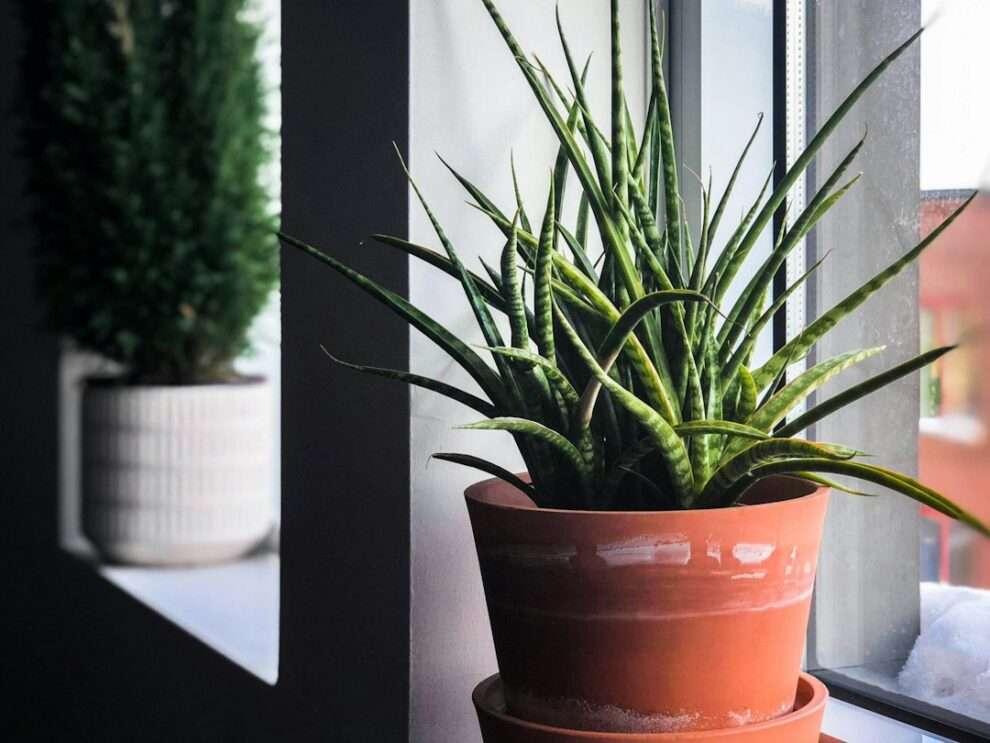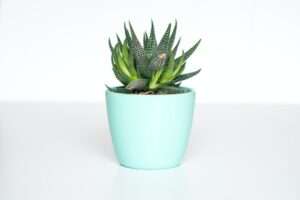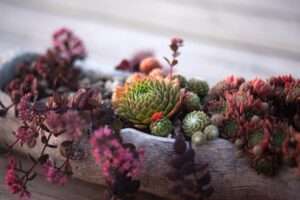Succulents have become incredibly popular in recent years, and it’s no wonder why. These unique plants are known for their ability to store water in their leaves, making them low-maintenance and perfect for those with a busy lifestyle. However, when it comes to caring for succulents, choosing the right pots is crucial. The right pot can not only enhance the beauty of your succulent display but also promote healthy growth and prevent issues such as root rot. In this article, we will explore the factors to consider when choosing pots for succulents and provide tips for selecting the perfect pots for your plants.
Factors to Consider When Choosing Pots for Succulents
Choosing the right pot is essential for the health and growth of your succulents. There are several factors to consider when making your selection, including the material, size, drainage holes, shape, and color.
Firstly, the material of the pot is an important consideration. The most common materials used for succulent pots are terracotta, ceramic, and plastic. Each material has its pros and cons. Terracotta pots are porous and allow for better airflow and drainage, which is beneficial for succulents that are prone to root rot. Ceramic pots are more decorative and come in a variety of colors and designs, but they are less breathable than terracotta. Plastic pots are lightweight and affordable but may not provide adequate drainage.
The size of the pot is another crucial factor to consider. It’s important to choose a pot that is proportionate to the size of your succulent. If the pot is too small, it can restrict the growth of the plant and lead to root-bound issues. On the other hand, if the pot is too large, it can hold excess moisture and cause root rot. It’s recommended to choose a pot that allows for about an inch or two of space around the roots of your succulent.
Materials for Succulent Pots: Pros and Cons
When it comes to choosing the material for your succulent pots, there are several options available, each with its own pros and cons.
Terracotta pots are a popular choice among succulent enthusiasts. These pots are made from clay and are known for their breathability. The porous nature of terracotta allows for better airflow and drainage, which is crucial for the health of succulents. However, terracotta pots can be prone to cracking in extreme temperatures and may require more frequent watering due to their ability to absorb moisture.
Ceramic pots are another common choice for succulents. These pots come in a variety of colors, shapes, and designs, making them a great option for those looking to add a decorative touch to their succulent display. Ceramic pots are less breathable than terracotta but can still provide adequate drainage if they have drainage holes. However, it’s important to note that ceramic pots can be heavier and more fragile than other materials.
Plastic pots are lightweight, affordable, and widely available. They are a practical choice for those on a budget or those who prefer a more modern look. Plastic pots are less breathable than terracotta or ceramic but can still provide adequate drainage if they have drainage holes. However, it’s important to choose high-quality plastic pots that won’t become brittle or crack over time.
Size Matters: Choosing the Right Pot Size for Your Succulents
Choosing the right size pot is crucial for the health and growth of your succulents. If the pot is too small, it can restrict the growth of the plant and lead to root-bound issues. On the other hand, if the pot is too large, it can hold excess moisture and cause root rot.
When selecting a pot size, it’s important to consider the size and growth rate of your succulent. If you have a small succulent that grows slowly, a smaller pot will be sufficient. However, if you have a larger succulent or one that grows quickly, you may need to choose a larger pot to accommodate its growth.
One way to determine the right pot size is to measure the plant. Measure the diameter of the plant at its widest point and choose a pot that is slightly larger than the measurement. This will allow for some room for growth without overwhelming the plant.
It’s also important to consider the growth potential of your succulent. Some succulents, such as Echeverias, can grow quite large over time. If you have a succulent with a high growth potential, it’s best to choose a pot that will accommodate its future size to prevent the need for repotting too frequently.
Drainage Holes: Why They are Important for Succulent Pots
Proper drainage is crucial for the health of succulents. Succulents are adapted to survive in arid conditions and are prone to root rot if their roots sit in water for too long. This is why drainage holes are essential in succulent pots.
Drainage holes allow excess water to escape from the pot, preventing water from pooling at the bottom and causing root rot. Without proper drainage, succulents can become waterlogged and develop mushy, rotting roots.
To ensure proper drainage, it’s recommended to add a layer of rocks or sand to the bottom of the pot before adding soil. This will create a space for excess water to collect and prevent it from sitting directly on the roots of the plant.
Choosing the Right Shape of Pot for Your Succulents

The shape of the pot can have an impact on both the aesthetics and health of your succulents. There are several common pot shapes to choose from, including round, square, rectangular, and even hanging pots.
When choosing the shape of your pot, it’s important to consider the size and shape of your succulent. Round pots are a popular choice for succulents as they provide a classic look and allow for even growth. Square or rectangular pots can be a great option for larger succulents or those with a sprawling growth habit. Hanging pots are ideal for trailing succulents or for those looking to save space.
It’s also important to consider the stability of the pot. Some succulents have top-heavy growth and may require a wider, more stable pot to prevent tipping over. Additionally, pots with narrower openings may be more suitable for succulents with rosette-shaped growth habits.
Terracotta vs. Ceramic Pots: Which is Better for Succulents?
When it comes to choosing between terracotta and ceramic pots for your succulents, there are several factors to consider.
Terracotta pots are made from clay and are known for their breathability. The porous nature of terracotta allows for better airflow and drainage, which is beneficial for succulents that are prone to root rot. Terracotta pots also have a natural, earthy look that many succulent enthusiasts appreciate. However, terracotta pots can be prone to cracking in extreme temperatures and may require more frequent watering due to their ability to absorb moisture.
Ceramic pots, on the other hand, are less breathable than terracotta but can still provide adequate drainage if they have drainage holes. Ceramic pots come in a variety of colors, shapes, and designs, making them a great option for those looking to add a decorative touch to their succulent display. However, it’s important to note that ceramic pots can be heavier and more fragile than terracotta.
Ultimately, the choice between terracotta and ceramic pots comes down to personal preference and the specific needs of your succulents. If you live in a hot, dry climate and are concerned about root rot, terracotta pots may be the better option. However, if you prioritize aesthetics and don’t mind watering your succulents more frequently, ceramic pots can be a great choice.
Hanging Pots vs. Regular Pots: Which is Ideal for Your Succulents?
When it comes to choosing between hanging pots and regular pots for your succulents, there are several factors to consider.
Hanging pots are a great option for those looking to save space or add a unique touch to their succulent display. They can be hung from ceilings, walls, or even in windows, allowing you to create a vertical garden. Hanging pots are ideal for trailing succulents or those with a cascading growth habit.
However, it’s important to note that hanging pots can pose some challenges when it comes to watering. The soil in hanging pots tends to dry out more quickly than in regular pots due to increased airflow. This means that you may need to water your succulents more frequently if they are in hanging pots. Additionally, hanging pots may not provide as much stability as regular pots, so it’s important to choose a pot that is secure and won’t tip over easily.
Regular pots, on the other hand, are the traditional choice for succulents and offer more stability. They come in a variety of shapes and sizes and can be placed on tabletops, shelves, or the ground. Regular pots are suitable for all types of succulents and provide ample space for growth.
Ultimately, the choice between hanging pots and regular pots comes down to personal preference and the specific needs of your succulents. If you have limited space or want to create a unique display, hanging pots can be a great option. However, if stability and ease of watering are your priorities, regular pots may be the better choice.
DIY Succulent Pots: Creative Ideas to Try at Home
If you’re feeling creative, there are plenty of DIY ideas for succulent pots that you can try at home. Not only can DIY pots add a unique touch to your succulent display, but they can also be a fun and rewarding project.
One popular DIY idea is to repurpose household items as succulent pots. For example, you can use old teacups, mugs, or even tin cans as planters. Simply drill drainage holes in the bottom of the item, add some soil, and plant your succulent. This is a great way to add a touch of whimsy to your succulent display and give new life to old items.
Another creative idea is to use unique materials for your succulent pots. For example, you can make pots out of concrete, hypertufa, or even recycled materials such as wine corks or old books. These unique pots can add a modern or rustic touch to your succulent display and make for great conversation starters.
If you’re feeling particularly crafty, you can even try making your own ceramic pots. There are plenty of pottery classes and tutorials available online that can teach you the basics of hand-building or wheel-throwing. Making your own pots allows you to create custom designs and sizes that perfectly suit your succulents.
Choosing the Right Color of Pot for Your Succulents
The color of the pot can have a significant impact on the overall aesthetic of your succulent display. When choosing the color of your pot, it’s important to consider the color and texture of your succulent.
If you have succulents with vibrant colors or unique textures, it’s best to choose a pot color that complements or enhances these features. For example, if you have succulents with red or purple leaves, a pot in a contrasting color such as white or black can make the colors pop. On the other hand, if you have succulents with soft, pastel colors, a pot in a similar shade can create a harmonious and calming effect.
It’s also important to consider the overall aesthetic you want to achieve. If you prefer a minimalist look, neutral-colored pots such as white, gray, or beige can create a clean and modern feel. If you want to add a pop of color to your succulent display, pots in bold or vibrant colors such as red, blue, or yellow can make a statement.
Ultimately, the choice of pot color comes down to personal preference and the specific characteristics of your succulents. Experiment with different colors and see what works best for your unique collection.
How to Maintain Your Succulent Pots for Longevity
Proper maintenance is essential for the longevity of your succulent pots. Here are some tips to keep your pots in great condition:
1. Watering: Succulents have unique watering needs and should not be overwatered. It’s important to water your succulents sparingly and allow the soil to dry out between waterings. Avoid letting water sit in the saucer or tray beneath the pot, as this can lead to root rot.
2. Cleaning: Regularly clean your pots to prevent the buildup of dirt and debris. Use a soft brush or cloth to remove any dust or grime from the surface of the pot. If your pots are made of terracotta or ceramic, you can also soak them in a mixture of water and mild dish soap to remove stubborn stains.
3. Repotting: Over time, succulents may outgrow their pots or become root-bound. It’s important to repot your succulents when necessary to ensure their continued health and growth. When repotting, gently remove the plant from its current pot, loosen the roots, and place it in a slightly larger pot with fresh soil.
4. Protecting from the elements: If you live in an area with extreme temperatures or harsh weather conditions, it’s important to protect your pots from the elements. Move your pots indoors during cold winters or provide shade during hot summers to prevent cracking or damage.
Choosing the right pots for your succulents is crucial for their health and growth. Factors such as material, size, drainage holes, shape, and color should all be considered when making your selection. Terracotta and ceramic pots are popular choices for succulents, each with their own pros and cons. Hanging pots can be a great option for those looking to save space or add a unique touch to their display. If you’re feeling creative, there are plenty of DIY ideas for succulent pots that you can try at home. Ultimately, the choice of pots comes down to personal preference and the specific needs of your succulents. By choosing the right pots and properly maintaining them, you can create a beautiful and thriving succulent display.
If you’re interested in succulents and want to learn more about how to choose the right pots for them, you might also enjoy reading this article on “Creating a Lush and Low-Maintenance Oasis: Tips for Designing Your Own Succulent Garden.” This comprehensive guide provides valuable insights and practical tips for designing a beautiful succulent garden that requires minimal maintenance. Check it out here.
FAQs
What are succulents?
Succulents are plants that store water in their leaves, stems, and roots. They are known for their unique and often unusual shapes and textures.
Why is it important to choose the right pots for succulents?
Choosing the right pots for succulents is important because it can affect their growth and overall health. The wrong pot can lead to overwatering, poor drainage, and root rot.
What kind of pots are best for succulents?
The best pots for succulents are those that have drainage holes and are made of porous materials such as terra cotta or unglazed ceramic. These materials allow for proper drainage and air circulation.
Can succulents be planted in plastic pots?
Succulents can be planted in plastic pots, but it is important to ensure that the pots have drainage holes. Plastic pots can retain moisture, which can lead to overwatering and root rot if there is no drainage.
What size pot should I use for my succulent?
The size of the pot you should use for your succulent depends on the size of the plant. As a general rule, the pot should be slightly larger than the plant’s root ball. It is important not to use a pot that is too large, as this can lead to overwatering and poor drainage.
Can I use decorative pots for my succulents?
Decorative pots can be used for succulents, but it is important to ensure that they have drainage holes and are made of porous materials. If the pot does not have drainage holes, it is recommended to use a plastic nursery pot with drainage holes inside the decorative pot.

















Add Comment